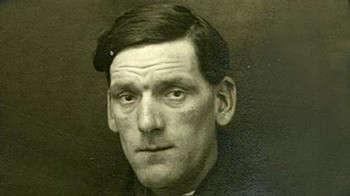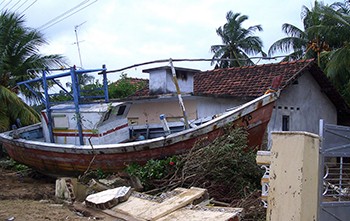5 Unkillable People Who Stared Death In The Face And Said "Not Today"

No one will fondly remember 2020. But we made it ... so far. Perspective is important, though, as things could certainly be a helluva lot worse. We mean being tortured, irradiated, or repeatedly drowning worse. Death comes for everyone, but these guys told it to try again later ...
Arthur John Priest - History's Most Accursed Mariner
Tending the furnace, the backbone of steam-powered ocean travel, kept English stoker Arthur John Priest in frequent demand. The job had obvious risks, but coal dust in his lungs would be the least of Priest's concerns.
Don't Miss
This particular "fireman," born with a target on his back, was assigned to the Titanic. You know those hundreds of computer-generated floating extras in the background at the end of the James Cameron movie? One of those blurry human ice cubes (not to be confused with the human named Ice Cube) was Priest. By the time he made it out of the boiler room, they were fresh out of rafts and life vests as "Safety standards" was a nebulous concept in 1912.

Shrugging off hypothermia, Priest went right back to work. And, what do you know, it happened again ... and again again ... and then one more time for good measure, just in case Priest still had any lingering hopes this whole "of the sea" thing being the right career path.
His second doomed ship was the merchant vessel Alcantara, which had been commandeered into military service during WWI ... until being sunk by a German raider. Priest's next assignment brought him back to where things started: on the Titanic's sibling, the HMHS Britannic ... and off it when the hospital ship went down after hitting a mine. His final sinking, the SS Donegal, was like a bad combo sequel of the previous two -- a hospital ship slammed by a German torpedo. After that, along with some other close calls and collisions along the way, Priest finally quit his regular gig (probably to the relief of every other sailor wishing to avoid sharing a boat with him) and died an uneventful death on land in 1937.
Tom Tuohy - The Man Who Was Immune to Radiation
In 1957, Tom Tuohy was the general manager of Windscale, a notorious nuclear facility in England. And if you never heard his story, well, that's hardly shocking, as the UK government did their best to cover up what transpired.
When a fire broke out, engulfing sections of the reactor/nuclear weapons complex, Tuohy took on the unenviable task of extinguishing it. He ordered his crew to lower him near the core to monitor the reactor shell for signs of an imminent explosion. There was no precedent for handling such a problem, leaving the manager writing the game plan on the fly. He had two options: vent the gas, contaminating the countryside to avert a pressure build-up, OR douse the radioactive hunk with water and risk it exploding and taking out Northern England, transforming Windscale into a desolate exclusion zone for hipster urban explorers wearing Supreme caps. Thankfully, Tuohy guessed correctly.

England dodged a calamity while Tuohy was bombarded by a prolonged, concentrated blast of radioactive dust to his face so toxic that all of the cow's milk produced within a radius of 200 miles was disposed of as a biological hazard. Yet, somehow, the Englishman lived to the ripe age of 90, showing no visible long-term effects of his being irradiated. If a diet of gelatinized eel, pork pies, and 79 different things called "puddings" can't kill you, nuclear fission doesn't stand a chance.
Rahmat Saiful Bahri - Lived Through Two Freak Tsunamis
2004 marked one of the deadliest natural disasters in recent history, with the Indian Ocean Tsunami (the result of a 9.1 earthquake) ravaging Indonesia, India, Myanmar, Sri Lanka, and Thailand. Almost a quarter of a million people died, many of whom were never found.
One of the survivors was Rahmat Saiful Bahri. The same can't be said for his friends and neighbors, who succumbed to the rapidly spreading tsunami that ambushed them, leaving swathes of Indonesia devastated. The wave was so powerful and spread so far that mountains were wiped clean of vegetation, roads disappeared, temporary lakes appeared out of nowhere, and 30-ton ships wound up stranded miles inland.

In 2018, Bahri had rebuilt his life, reasonably assuming one traumatizing nightmare per lifetime was sufficient to meet his quota. Feeling tremors while visiting Palu, Bahri was subjected to a tidal wave, this time while he was in the shower. Settling for just a lather and rinse, saving repeat for another time, Bahri sprang to action. Knowing from first-hand experience that an earthquake often precipitates a wave, Bahri moved his family to the highest ground available -- now fully aware he was on Mother Nature's hit list. The 10-foot wave ripped apart the Indonesian city, forcing Bahri to witness his life flash(-flooding) before his eyes twice.
Armando Soccarras Ramirez - The Luckiest Hitchhiker in History
Cuba was no paradise after Fidel Castro seized power, leading to 17-year-old Armando Ramirez being so determined to get the hell out of Cuba he decided to take a flight.
One tiny problem: He could not secure travel outside of the nation. Armando and his pal, Jorge, concocted an all-or-nothing gamble that they knew the authorities of Havana's Jose Marti Airport could never have imagined. Hopping a fence, they jumped on a taxiing Iberia Airlines plane, tying themselves to the landing gear. As you guessed already, a DC-8 wheel well is a terrible place for a number of reasons besides the deafening noise and risk of having limbs crushed by hydraulics.

On its way across the Atlantic to Madrid, the airliner reached a height of 29,000 feet, with the temperature dropping to -41 degrees F. What he lacked in common sense, Ramirez made up for in fortitude, outlasting the cold, air pressure, and lack of oxygen. Ramirez walked away just with a minor case of frostbite, unlike his friend who got wheeled away with a major case of dead AF. The Cuban ex-pat eventually reached America after recovering for a couple of months, no doubt wondering if it would have been quicker and safer to just swim.
Werner Gustav Doehner - The Boy Who Escaped The Hindenburg
The child of a drug company exec, Werner Gustav Doehner, enjoyed the majestic sights of the ocean as he returned to Mexico City in 1937. Along the way, his family's blimp stopped off in a routine landing. However, this dirigible was no ordinary flight. It was the Hindenburg. Yup, that Hindenburg.
Settling the moorings at a New Jersey airfield, a fire from a static electricity build-up sparked the hydrogen fuel. Doehner recalled the balloon abruptly tilting backward and then the very air igniting with the hydrogen leaking into the fuselage. At a height of about 180 feet, the balloon was now on fire and plummeting headfirst to the Earth as occupants gasped to stay conscious.
8-year-old Doehner experienced a bout of extreme good fortune. He was small and light enough to be tossed out a window by his mother, his older sibling not so lucky. Hitting the ground with limited injuries despite the fall, the boy scampered away with a head start that many others weren't afforded. Avoiding the superheated gases, tons of metal, jagged glass, and debris raining down all around him, his tiny limbs hauled ass to escape the choking fumes. The Hindenburg was rendered a pile of warped metal and smoldering ashes in about the same time as a TV commercial:
Doehner passed away in 2020, the last survivor of the Hindenburg. Despite his claim to fame, he kept his mouth shut until 2018, staying far from the spotlight and foregoing book deals and TV movies, staving off panic attacks every time he laid eyes on his grandkids' Led Zeppelin concert tees.
Top image: Everett Collection/Shutterstock, U.S. Navy